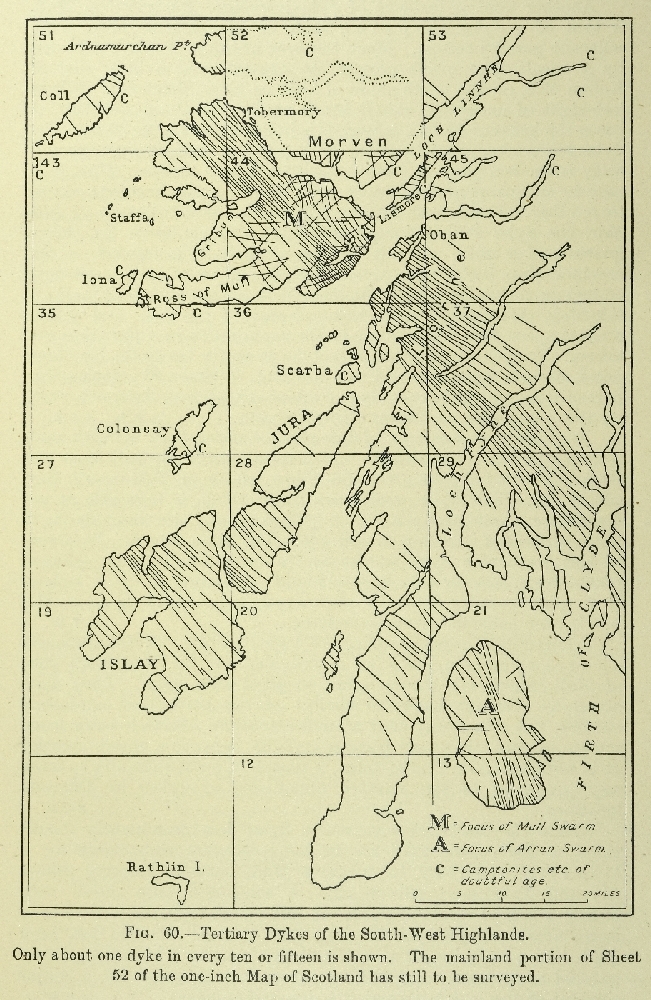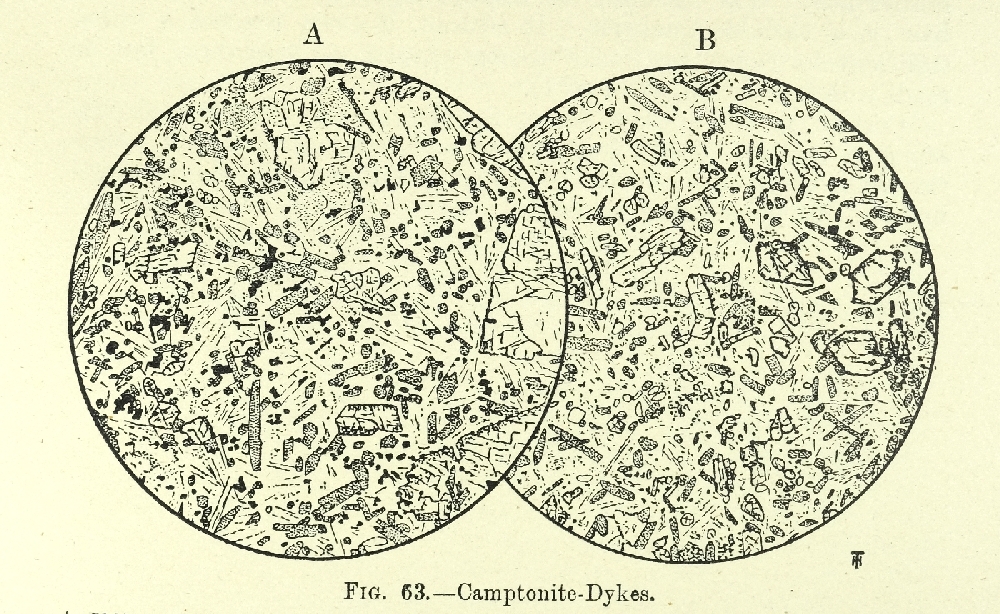Chapter 35 Camptonites, etc., of doubtful age
Introduction
True camptonites were first distinguished in Britain by Dr. Flett,
Dr. Flett
Dr. Flett's discussion of the age of the Scottish camptonites, as given in the Caithness Memoir, may be turned to by anyone wishing for an introduction to this difficult subject. Further assistance is afforded by
The camptonitic assemblage, recognized at several places in the West Highlands, agrees very closely in petrological type with what is characteristic of the Orkney-Glenelg country farther north. On the other hand, the predominant direction for camptonite-dykes in the West Highlands is north-west, and not east-north-east as it is farther north.
Thus the camptonites of the West Highlands agree in trend with the undoubtedly Tertiary dykes of the same region. More over, when a large collection of slides is examined, it becomes evident that the camptonites are petrologically united with basalts of a type such as undoubtedly figures largely among Tertiary lavas and intrusions of Mull. On these two grounds, it has been thought, with varying. degrees of confidence, that the camptonites of the West Highlands may be of Tertiary age.J. S. Flett in The Geology of the Country near Oban and Dalmally, (Sheet 45), Mem. Geol. Surv., 1908, p. 124; C. T. Clough, W. B. Wright, and E. B. Bailey in The Geology of Colonsay and Oronsay with parts of the Ross of Mull (Sheet 35),Mem. Geol. Surv., 1911, pp. 41–88.
At the same time, the fact remains that, while typical camptonites, monchiquites, etc., occur round about Mull, and even in Mull itself, they have not yet been found cutting Mesozoic sediments or Tertiary lavas. Furthermore, wherever camptonite-dykes are seen in contact with undoubted Tertiary intrusions in the West Highlands, the rule seems to be that the camptonite dyke is cut by its companion. Dr. Harker,
The evidence, as outlined above, does not permit of any certain conclusion. At the present time, however, the writer is inclined to adopt the Tertiary hypothesis, with the proviso that most of the West Highland camptonites are amongst the earliest manifestations of the Tertiary magma. Before elaborating these suggestions, it is well to give an account of the Ross of Mull and Morven occurrences, which seem, at first sight, to point in the opposite direction.
R.B.B.
- Ross of Mull – It has been shown in the Explanation of Sheet 35 that most of the north-west dykes met with on the south coast of Mull beyond the Loch Assapol (Sheet 43) boundary-fault of the Tertiary lavas are of the camptonitic suite. Out of ten sliced specimens, four have been determined by Dr. Flett as camptonites, one as fourchite, two as monchiquites, and three as dolerites or basalts. One of the dolerites (S14445)
[NM 4324 1814] is certainly cut by the Tertiary xenolithic sill of Tràigh Bhàn na Sgurra (p. 266), and the same is in all probability true of the fourchite (S14446)[NM 4327 1814] ; in addition, the latter is crossed by a number of small faults. The rest of the Ross of Mull evidence can be left to the 'Explanation' of Sheet 43. Here, it is enough to say that the camptonitic dykes are fairly well represented westwards right out into iona. (C.T.C) The Loch Assapol boundary-fault runs roughly parallel with the dykes of its neighbourhood. The Tertiary lavaa on its north-eastern side, are, at first, markedly deficient in dykes of any sort. Even where, after some miles, dykes occur in profusion, typical eamptonites, fourchites, or monchiquites are absent; or, at least, they have not been found in spite of free collection and slicing from all parts of the island. E.B.B. - Loch Aline, Morven –The same absence of camptonites seems to characterize the Tertiary lava-area of Loch Aline. But, across the boundary-fault of Inninmore, (p. 181), camptonites are fairly well-represented on the mainland, and also, as Mr. Maufe found, in Lismore. The reappearance of camptonites is certainly striking, considering their absence throughout many intervening miles; but none of them is found, in the Loch Aline district, within 1½ miles of the lava-boundary, nor indeed aiming straight at it. Almost all the occurrences noted have been inserted on the one-inch Map and lettered C. Two of these are of particular interest, since, in them, camptonite is cut by normal Tertiary basaltic types.: one shows an east-and-west camptonite (S15844)
[NM 8198 4579] , on the coast south of Camas Lèim an Taghain, cut by a north-and-south basalt, similar in type to a Plateau Lava (S15843)[NM 8198 4579] ; the other, a north-west camptonite (S15785)[NM 7667 4572] , in a stream north-east of Allt Dubh Dhoire Theàrnait, cut by a north-and-south tholeiite of Salen Type (S15784)[NM 7667 4572] . It will be noticed, from the above, that the camptonites of the Loch Aline district vary considerably in direction; but their prevalent trend is roughly north-west. In Lismore, Mr. Maufe has found that they share with their companion basalts a tendency to run west-north-west. G.W.L.
If one had no more evidence in regard to the distribution of camptonites round about Mull, their occurrences in the schist and granite parts of Morven and the Ross of Mull, and their absence from the intervening lava-fields, would seem to point almost conclusively to a Pre-Tertiary date of intrusion. As a matter of fact, this evidence stands for nothing, since camptonite s are unknown in the Mull Swarm from Oban to the Clyde. To supplement earlier enquiries, Mr. Tait collected a suite of forty-eight specimens across the swarm from Sloc nan Uan on the west coast of Sell (near southern edge of Sheet 44), northwards to near Barrnacarry Bay (S18993)
Barrnacarry Bay (see above) (S18993)
Accordingly, the absence of camptonites in the greater part of Mull is not due to their concealment under Mesozoic and Tertiary cover.
Other evidence which has been collected bearing on the question is as follows:
1. Camptonites are unrepresented among the few dykes which cut the Moine Gneiss, exposed beneath Tertiary lavas for four miles in a north-easterly direction along the shores of Gribun and Inch Kenneth (Sheet 43). Visitors must be warned against a very deceptive appearance afforded by a 2 ft. west-north-west basalt-dyke on the West shore of Inch Kenneth. At a point noted on the one-inch Map, this dyke traverses the gneiss of the foreshore, but ends in the cliff 10 ft. below the base of the Trias. One has to climb up the cliff-face to realize that the dyke ends below the base of the Trias, and is not cut off by the same.
2. The absence of camptonite-dykes from the Mull Swarm and its immediate neighbourhood no longer holds good in Coll, where Mr. V. A. Eyles and the writer have found north-west camptonites striking at the lava-field of Mull.
3. On the other hand, camptonite-dykes do seem to be absent from the western half of the Aramurchan peninsula. Messrs. Eyles, Simpson, and the writer have found them well-represented in the eastern half of the peninsula, where they continue the camptonitic belt of south-east Morven, Lismore, and Arnamucknish.
4. Though typical camptonites are unknown from the lava-held of Mull, at least one camptonitic basalt (or dolerite) has been met with (p. 369), which might possibly be classed as camptonite. Then, too, one cannot lose sight of the somewhat camptonitic affinities of many of the Mull dykes and lavas—more especially in the case of lavas with ocellar segregations (Chapter 10). Not only so, but the occasional mugearites (Chapter 10), trachytes, bostonites, and syenite (Chapter 14), are just such associates as one expects to meet with camptonites.
5. Though rocks of camptonitic affinity recur in the Mull petrological timetable, it is almost certain that the West Highland camptonites, if Tertiary at all, are of relatively early date; for they have often been seen cut by other Tertiary intrusions. Perhaps an early date in some small measure accounts for their not being found exposed in the region of depression occupied by the lava-field; but it is difficult to press this suggestion in view of the apparently continuous absence of camptonites along the track of the Mull Swarm south-eastwards to the Clyde. E.B.B.
Petrology
For the most part the dykes of the present chapter are fairly uniform in their microscopic characters, but vary amongst themselves to some extent in the relative abundance of their constituent minerals, among which first one bisilicate and then another gains preponderance. They are holocrystalline rocks with the typical panidiomorphic structure of the lamphrophyre-group; and are composed essentially of olivine, purple augite, deep-brown hornblende, soda-lime and alkali-felspars, and magnetite, with generally some analcite as the ultimate residual product. The felspar appears to be dominantly plagioclase; but orthoclase is usually, though not universally, present. The residual analcite occurs alike in the base, in vesicular cavities, and in ocelli. Quartz has not been detected.
Dr. Flett, whose writings have been quoted freely in the earlier part of this chapter, was the first to claim that Scottish dyke-rocks with the characters outlined above are true camptonites; and, at the same time, he pointed out that the name had previously been misapplied in Scottish literature. Dr. Flett's determination of the camptonites was largely based upon the colour of the augite and hornblende, and the presence of analcite, instead of quartz, as a residuum. He arrived at his conclusions after comparison of Scottish material with slides from continental areas; and his results have been accepted by Sir Jethro Teall and Rosenbusch.H. Rosenbuch, Mik. Phys. d. Min. and Gesteine, 1907, Bd. ii., 1, p. 170, also E. B. Bailey The Geology of Ben Nevis and Glen Coe, Mem Geol. Surv, 1916, p. 157.
The figured Lismore dyke (S13744)
The approach of certain dykes to the composition of vogesites is shown by the occasional increase in the amount of alkali-felspar (S13751)
In Morven, the hornblende-rich rocks constitute the dominant variety, and the figured example (S15788)
Certain of the dykes have, in the main, distinct doleritic affinities (S15795)


